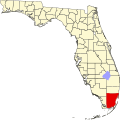2020 census
As of the 2020 United States census, there were 9,923 people, 3,483 households, and 2,782 families residing in the CDP. [9]
As of the 2010 United States census, there were 9,650 people, 2,923 households, and 2,170 families residing in the CDP. [10]
2000 Census
At the 2000 census there were 9,692 people, 2,914 households, and 2,235 families living in the CDP. The population density was 3,109.2 inhabitants per square mile (1,200.5/km2). There were 3,111 housing units at an average density of 998.0 per square mile (385.3/km2). The racial makeup of the CDP was 17.01% White (3.9% were Non-Hispanic White), [11] 75.63% Black or African American, 0.43% Native American, 0.41% Asian, 0.13% Pacific Islander, 3.01% from other races, and 3.36% from two or more races. Hispanic or Latino of any race were 19.76%. [3]
As of 2000, there were 2,914 households 37.6% had children under the age of 18 living with them, 37.1% were married couples living together, 31.4% had a female householder with no husband present, and 23.3% were non-families. 19.0% of households were one person and 7.7% were one person aged 65 or older. The average household size was 3.32 and the average family size was 3.74.
In 2000, the age distribution was 31.2% under the age of 18, 11.1% from 18 to 24, 25.6% from 25 to 44, 22.6% from 45 to 64, and 9.5% 65 or older. The median age was 31 years. For every 100 females, there were 88.2 males. For every 100 females age 18 and over, there were 81.4 males.
In 2000, the median household income was $28,943 and the median family income was $31,289. Males had a median income of $23,052 versus $22,933 for females. The per capita income for the CDP was $11,887. About 23.2% of families and 26.0% of the population were below the poverty line, including 32.4% of those under age 18 and 24.9% of those age 65 or over.
As of 2000, speakers of English as a first language accounted for 68.37% of residents, while Spanish made up 20.61%, French Creole was at 10.16%, and French was the mother tongue of 0.84% of the population. [12]


